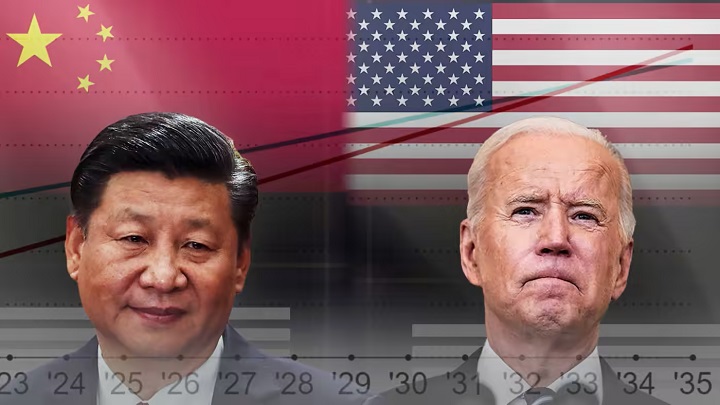
Is China right in believing America is in a mortal crisis? For many years, openly or not, many Chinese pundits have been thinking that China was rising and America was declining, because in a mortal crisis. This is one of the important elements conditioning Chinese strategy, however is the assessment correct?
A different set of cultural values may have impaired the Chinese vision of the US and the world. It is very critical for everybody to do a cold assessment.
Chinese see the following.
America is falling behind on the international scene. It didn’t manage well in the Middle East and Central Asia; most of all, its US dollar is not what it used to be.
It is feeding a massive financial crisis with its enormous trade deficit, creating a colossal imbalance in global commerce. Its companies and entrepreneurs want to move out of the country, seeking better returns, and therefore the country has been deindustrialized in the past three decades.
America is an empty shell; it no longer has blue-collar workers, and no longer creates industrial, practical, and day-to-day innovation. There may be technological leaps and bounds, but the manufacture is done elsewhere at the end of the day.
Its society is divided, bickering with one another, turning more violent and more acrimonious; it is as if Latin America is eating up the United States. The United States of America is turning into a larger Mexico, as Mexico is also falling into greater chaos with the growing political influence of criminal gangs and organizations. Law and order are in the hands of a few semi-criminal organizations.
Looking at things from China, the country faces horrible infrastructure decay and disarray, and drug culture has infected all social layers with legal or illegal supplements. The idea is that every social contradiction and problem can be fixed by giving medication and tablets, even to children.
The appalling state of the suburbs and the equally appalling luxury of the rich send a clear message to China that America is like China during the Qing dynasty’s final stages—total decadence, ready to fall apart.
In this Chinese analysis, the impression may be true or may be false. It may have some valid points, or it may not be entirely accurate. However, China’s idea of replacing America as the number-one global power needs to have more than a simple concept of replacement as if in a race.
Still, even if that were totally true, there would be the issue of what kind of world China wants to build and who would follow it.
It needs a global overview because America came from 500 years of a certain kind of rule of the world. As China is unwilling to take on that 500-year legacy and is eager to turn to its own rules, it’s worth looking deeply into what China is apparently thinking of the world.
Different world, different culture
Despite the objective social and economic difficulties of the United States, the world is geared toward Western culture. But this Western culture is not what China now apparently wants. It wants something different.
Two books written over a decade ago outline what China may look like in the future. One is The New Warring States Period (Xin Zhanguo Shidai, 2004) by Qiao Liang, Wang Xiangsui, Wang Jian, and Li Xiaoning. The four see a world where a few states compete with one another, but it is fairly stable despite the name.
At first, the book was supposed to be titled The Time of the Springs and Autumns. Still, after some thinking, the authors changed it because they didn’t wish to invite controversy: In the Spring and Autumn period, between the 8th and 5th century BC, hundreds of states were destroyed. In contrast, in the following period, the Warring States period, the situation remained fairly stable until the unification by the Qin emperor.
The second book, The System of All Under Heaven by Zhao Tingyang (Tianxia Tizhi, 2005), tries to explain and present a worldview where everybody has to agree to a common global interest and preserve it. The different balance of power can be maintained thanks to a common interest in joint development.
These two views hark back to the time before the Qin unification when actually the Yellow River Basin was divided into many states competing with one another. This provided some kind of pattern to interpret, read, and project a Chinese-style worldview based on its history and culture.
A traditional worldview, emerging after the Qin unification, held China together for some 2,000 years through centuries of occasional turmoil and uprisings that all ended in a renewed unification.
Until the 19th century, for 2,000 years, China basically had a very simple worldview: The empire’s unity must be preserved at all costs. Once the central state is strong, everything will fall in order and no external challenges will be strong enough to topple the system.
This worldview was based on China’s geographical position and its political history. The geographic position was the semi-isolation of China. That is, China didn’t border any major powers with which it had to balance its territorial clout.
Its only major challenge would be the internal order that could give rise to rebellions, and threats from people from the north of China, Siberia, and Mongolia, who lived in a land deprived of most income but had the horses necessary for the Chinese war efforts and economy.
Besides this external pressure, there was the risk of an internal uprising triggered by a financial/tax crisis that impoverished farmers. People from the north could take advantage of a crisis and overthrow the internal order.
It happened with the Tang dynasty (618–907), semi-Turkic people at the border of the empire; it was identical with the Mongols (1271–1368) and with the Manchu (1644-1911). In some cases, as with Han (BC 202-220 AD) or the Ming (1368–1644), a peasants’ uprising was successful and established a new domestic dynasty. With the Qin (221–207 BC), the Sui (581–619), or the Song (960-1279), the new empire emerged from the factional fights among rival kingdoms.
Then, basically, China’s grand strategy[1] was fairly simple. Keep order within the state and keep foreigners at bay.
However, this pattern was broken by the 1841 Opium Wars when the English, the French, and the Western powers challenged the Qing power. Then, unlike the past northern invaders, these foreigners didn’t depose and replace the Manchu emperor with a new dynasty. The new foreigners just tried to change and bend the existing rules of the Chinese empire.
It was a double challenge. First, for the first time the crisis came from the sea; it came from the south and not from the land and the north. Then a military defeat and a different balance of payment created by the import of opium and the sudden outflow of silver triggered the internal uprising of the Taiping. In the past it was the other way around; there was first an economic crisis and an uprising and then a military defeat and an invasion. This time it was first a defeat, then an uprising.
The second element was the foreign invaders. They took Beijing and ransacked the Imperial Palace; they didn’t establish a new dynasty in Beijing, but always tried to deal with the existing dynasty or the existing Chinese government.
Of course, they pushed the existing government, but the foreigners didn’t establish their own government in China, unlike past northern invaders.
China was seeing a world that was very different from the past, but apparently didn’t quite compute, as Mao Zedong retook power rehearsing the past pattern of the Chinese peasant rebellions with some alliance with a northern power, i.e. Russia in this case.
The Communist Party came to power re-proposing the old imperial pattern.
Now can this imperial pattern be a way to think about the present? The two books seem to disagree, and tend to believe that a time when China was divided can provide a better paradigm to think of the world and about the future.
Ancient Chinese politics and military
In the classics, before the 202 Qin unification, we have records of two grand strategies competing with one another. We have the theories of horizontal or vertical alliances—that is, the states have to align themselves in the vertical axes or the horizontal axes to keep a balance of power.
However, we have two other grand strategies underneath the theories of alliances—one first expressed by Guan Jun and one by Mozi, both 5th and 4th-century BC philosophers.
The strategy expressed by Guan Jun, a famed prime minister of the Qin state in the 5th century BC was fitting for the newly large and expanding state. He explained that the state must be well organized. Organization means wealth, more population, then more peasants, and higher agriculture production. Peasants mean soldiers, and grain means logistics provision.
Therefore, more land meant wealth, children, and soldiers. If that could be well organized, the state would be powerful and could expand. With the expansion came new land, new wealth, and new people.
The second theory, the one from Mozi, actually stresses the interests of small states and the importance of holding the balance of power. It could be attained by giving power to the Son of Heaven, who at the time of Mozi was a figurehead with no real power.
But Mozi wanted to preserve the small states, which were fighting the larger states and were annihilated (mie 滅) by them. An annihilation at the time meant that all males would be killed, children and women were incorporated into the families of the invaders, and original cultures, temples, and cults would be banished and destroyed.
Mozi argued based on moral issues that the invasion of a smaller state was just like thieving and that a better order in which everybody would respect one another should be kept.
It was seeing things through long-term self-interest: If one after the other all states but one were destroyed, only the last survivor had an interest in the continuous wars. The majority of states, which would be destroyed this way, had an interest in a balance of power.
Moreover, states could thrive on intensive labor, intensive farming, thrifty expenditures, and strong defense, making conquest unbearably harsh even for large states. That is: better organization could do even with little land without expansion. Both stressed state organization.
Eventually the Mohist suggestion failed and Guan Jun’s suggestion prevailed. But in this we can also see a pattern underlying some of the Chinese thinking.
From the stories preserved about the Mohists in the Lüshi Chunqiu, we know the Mohist masters and practitioners were fighters, not abstract philosophers. They helped ailing states and died fighting for them.
However, they were also the exception in the Chinese system. In the rest of Chinese philosophy, we see a clear distinction in the state order.
There is the ruler and his officials, the generals, and the troops who were originally farmers, the ordinary people. We can see from the words that came back to us they were pretty different in their order.
The “ren” 人 (from the pictogram of someone bowing to a master) were actually the people who obeyed and bowed to others. The “min” 民 were possibly semi-slaves as the pictogram indicates people blinded in one eye, therefore making it difficult for them to run away. The “baixing” 百姓, the hundred surnames, were people privileged with having a surname, and therefore they were higher up in the social ladder. The “jun” 君 were people who gave orders as the pictogram indicates a mouth with two hands stretching before it. And lastly the “wang” 王, the king, was a semi religious figure that put straight, in order, heaven, nature, and society, the three horizontal lines connected with one straight vertical line.
It was a clear distinction of roles and we also find in Chinese history different military formations, each with its value but none which was prevailingly strong compared to the others.[2]
Each military formation had its pros and cons, military strategists reasoned. The word for military formation 陳 indicates chariots with a hill behind. Thus protected, it therefore can advance unhindered. Another military formation is reflected in the word that later came to mean war, zhan 戰 , which indicates holding spikes and halberds in no specific order.
Greek order
This is a very different situation from ancient Greece. The Greeks confronting the Persians had a unique advantage, the phalanx, a very organized formation made of shields and spears in which all free citizens fought one next to the other. The kings in Sparta were generals and fought in the phalanx. They were not far behind their fellow citizen-soldiers.
The general and the king and the soldier were in fact the same person.
Socially below this group of soldiers were the slaves, people deprived of any rights, therefore society was bitterly divided in two.
But within the military oligarchy, there was an equality that was otherwise unseen in China. The idea of the equality of the phalanx was passed on to the Roman legion, where roughly the thrust of the spear was replaced with that of the defensive/offensive shield, and the wall of spears was replaced by different groups of shielded soldiers that could move according to orders.
But in all these divisions, there was also a social organization; soldiers were farmers defending their farmland, obeying the order of the general who was one of them and was also the political commander. The discipline, the idea of a common cause, could win the day even against a much larger number of troops, as happened against the Persians, with the Macedonian phalanx and with the Roman legion.
Social and military discipline, the idea of a common cause, could carry the day.
Conversely, in Chinese tradition, the great power was fielding large numbers of well-armed and well-clad soldiers that could defeat smaller numbers of less-equipped soldiers.
But to have large amounts of people and weapons, the state had to be well organized, the farmland had to be well divided, able to provide the most. Then, therefore, the state organization, growingly more efficient thanks to an even better structured bureaucracy, was the ultimate weapon and offensive tool for a state. The military formation, discipline, and esprit de corps were not that important.
In Rome, farmland was essential, but the empire was based on controlling the Mediterranean Sea. Therefore, commerce, raids, and invasions to acquire wealth were the DNA of the Roman Empire, as it was of the Greek city-states.
It was all very different from the Chinese state. This also led to another way of thinking.
From combat to medicine
If the strength of bureaucracy is the real force behind the state’s power, then one can look at different state organizations and gauge who is stronger or weaker. Consciously or unconsciously, modern China, looking at the organization of the American state and the weaknesses of its trade deficit, tends to believe that the US will not manage the brunt of the assault of a better organized Chinese state.
Is that true? Another difference that we can see in the two different ways of thinking about war has its consequences in medicine, since early on Greek medicine was concentrated on surgery.
Why surgery? Because soldiers, kings, and generals were wounded in battle and therefore had to be healed. They had to recover from wounds. Surgery is about injuries and accidents.
Conversely, Chinese medicine traditionally has little to say about the surgery and no real tradition to speak of. It concentrates on extending life, having a better life, and improving circulation. That is, it was geared not toward the wounded in battle but toward the officials and the kings who when they were old wanted to extend their lives. These people didn’t fight or get hurt in combat. Wounded soldiers were apparently expendable, as we have little or no records of healing them after combat.
In fact, we know from historian Sima Qian that after large, decisive battles, soldiers captured were decapitated and killed. Ancient Chinese didn’t even bother to heal and enslave them, as happened in ancient Rome or Greece, where captured enemies were the workforce for large agricultural estates, mines, and rowing battleships.
Wounded soldiers apparently were not treated, their wounds not tended: If you are defeated in a battle, you are dead. If you are wounded in a fight, you are dead. Apparently, in most cases, it was as simple as that.
In other words, an ancient Chinese man had only the duty to serve his ruler there was a clear-cut hierarchy about who organizes and who is organized. The life of the state and thus his own, depended on this loyalty. Their fate was determined by the favors of the ruler.
Conversely, people in the legion or the phalanx were in theory all equals. Their life and the life of the general-king depended on this mutual trust of the people on the line. Therefore, they had their own rights to a portion of the loot or to defend their farm rights. Their property rights were their first rights altogether.
These rights didn’t exist in China, but these rights were the founding elements of Greco-Roman thinking. In China the top ruler only had power, not rights, could allow privileges in a very discretionary manner, and nobody could claim any better. The Greek philosophers spoke to their fellow people and had to convince them. Socrates did it by asking leading questions. Generals in Greece but also all through western history, spoke to soldiers to motivate them for battle.
We don’t have Chinese generals’ speeches to their soldiers.
The Chinese philosophers spoke to the ruler, and persuaded him by answering his questions, which were his concerns.[3] Through the different attitudes of the philosophers, we know who was the supreme power in the different systems. In Greece, it was the free people who voted for or against a policy; in China, it was the king. The king was the only really free man, without masters. In Greece or Rome everybody was free but everybody had to serve/consider the others, as in the battle line. There were rights and there were duties.
There are pros and cons in both systems.
The Chinese way produced a more rational, efficient system. In ancient Rome, the drawback of having many competing rights, and rights also competing with the supreme leader, was to have a constant state of confusion, competition, and war.
The drawback of the Chinese system without rights was to have peace in return for individual liberty and personal power.
The Reforms
The great revolution brought to China with the policies of reforms in the 1980s and 1990s was to make everybody dream that their child could be an emperor—the popularization of the “emperor” as the only man in China free and master of his life. It was no longer the case that the emperor was only to be one. Everybody in China could aspire to be an emperor, have their own business, be independent, and do what they wanted.
But, of course, different emperors with absolute powers created confusion, collision, also because, possibly everybody took his rights but didn’t know his duties. Therefore, a new order that had to be reset. It happened with President Xi Jinping’s drive to concentration of power in his hands.
The resetting that was decided on was not to try to set in order the different powers of the different “emperors” and mutually limit their powers, it was not to establish rights and duties, something organizationally very challenging and unprecedented in Chinese history. It was to give all powers back to the one “emperor.”
It might have been a reasonable choice. However, it has many drawbacks.
The two systems have competitive advantages. A system like the Chinese one, stressing the organization of the state for full efficiency, may have the benefit of resiliency.
However, this advantage has failed twice already in the past, with the Ming dynasty in the late 16th century and with the Qing dynasty in the 19th century. Both were adversely affected by the global market started and dominated by the Spanish, with the Ming, or by the English, with the Qing.
The Ming dynasty first hoarded silver from trading with Spain, and when silver from Mexico and Spain stopped coming in, there was a financial crisis.
Similarly, when the Qing dynasty stopped hoarding silver from the tea trade and was forced to pour out silver to buy opium, equally the dynasty failed.
Now we have a great imbalance again, almost similar to that of the Ming and the Qing. China ran a huge trade surplus in both cases, but this trade surplus can be attacked in many ways, and the domestic economy could collapse.
The American weakness is the permanent weakness of the capitalist system and of the Western system, which thrive in chaos and sometimes in chaos collapse—but most of the time come back stronger than before.
It’s hard to gauge whether this crisis right now is fiercer than the crisis in the 1960s when the United States was in the middle of the Cold War and domestic turmoil, or it was worse than the aftermath of the 1929 financial crisis, or during the Civil War in the 19th century.
American problems are immense and cannot be trifled with; however, China may have more significant issues of its own, and at the end of the day, it is not about who is more robust but who is weaker. Plus, when America confronts problems from outside traditionally finds a greater domestic unity.
Finally, it is not just America but the “American world.” Like it or not, the world is an American basin.[4] It is like a modern UN, a place where every country can plead its case and lobby for the support of its causes.
Can China survive if it doesn’t improve its ties with the US and the US world?
Now many Chinese pundits try to argue for “fighting without breaking”, that is arguing with the US without breaking its bonds with America. But this was possible only as long as the US trusted that China would become part of the “US world” sooner or later. Now the US stopped believing it and therefore fighting in any form the US is now breaking out with it. China’s room for maneuver is getting tighter and difficult. But just because of this it is the time of calm, patience and imagination.
[1] I have to thank Edward Luttwak for over 20 years of discussions on the subject
[2] See The following passage in Wuzi:
臣請論六國之俗:夫齊陳重而不堅,秦陳散而自鬭,楚陳整而不久,燕陳守而不走,三晉陳治而不用。
夫齊性剛,其國富,君臣驕奢而簡於細民,其政寬而祿不均,一陳兩心,前重後輕,故重而不堅。擊此之道,必三分之,獵其左右,脅而從之,其陳可壞。秦性強,其地險,其政嚴,其賞罰信,其人不讓,皆有鬭心,故散而自戰。擊此之道,必先示之以利而引去之,士貪於得而離其將,乘乖獵散,設伏投機,其將可取。楚性弱,其地廣,其政騷,其民疲,故整而不久。擊此之道,襲亂其屯,先奪其氣。輕進速退,弊而勞之,勿與戰爭,其軍可敗。燕性愨,其民慎,好勇義,寡詐謀,故守而不走。擊此之道,觸而迫之,陵而遠之,馳而後之,則上疑而下懼,謹我車騎必避之路,其將可虜。三晉者,中國也,其性和,其政平,其民疲於戰,習於兵,輕其將,薄其祿,士無死志,故治而不用。擊此之道,阻陳而壓之,眾來則拒之,去則追之,以倦其師。此其勢也。
[3] I have to thank professor Li Xiaoning for raising this point to me.
[4] https://sinification.substack.com/p/how-china-should-engage-with-washington






Francesco, please take a look at my new book, Engaging China, for a different interpretation of China’s view of the US, based on my reading of what China’s America watchers are saying. Criticisms of the US are only one part of the Chinese view; the other part is full awareness of US power, the belief that China is less important to the US than the US is to China, and the conviction that the US must take the lead in dialogue on the two countries’ differences.
Best wishes.